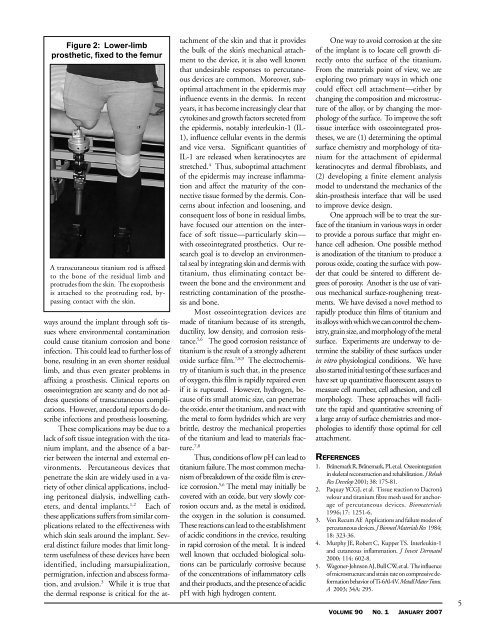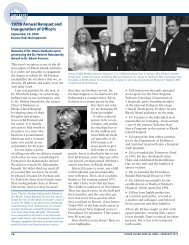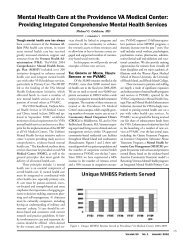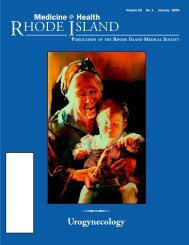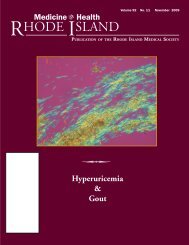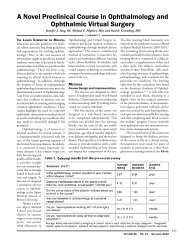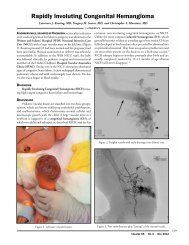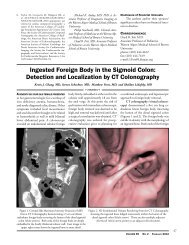Biohybrid Limbs - Division of Biology and Medicine - Brown University
Biohybrid Limbs - Division of Biology and Medicine - Brown University
Biohybrid Limbs - Division of Biology and Medicine - Brown University
Create successful ePaper yourself
Turn your PDF publications into a flip-book with our unique Google optimized e-Paper software.
Figure 2: Lower-limb<br />
prosthetic, fixed to the femur<br />
A transcutaneous titanium rod is affixed<br />
to the bone <strong>of</strong> the residual limb <strong>and</strong><br />
protrudes from the skin. The exoprothesis<br />
is attached to the protruding rod, bypassing<br />
contact with the skin.<br />
ways around the implant through s<strong>of</strong>t tissues<br />
where environmental contamination<br />
could cause titanium corrosion <strong>and</strong> bone<br />
infection. This could lead to further loss <strong>of</strong><br />
bone, resulting in an even shorter residual<br />
limb, <strong>and</strong> thus even greater problems in<br />
affixing a prosthesis. Clinical reports on<br />
osseointegration are scanty <strong>and</strong> do not address<br />
questions <strong>of</strong> transcutaneous complications.<br />
However, anecdotal reports do describe<br />
infections <strong>and</strong> prosthesis loosening.<br />
These complications may be due to a<br />
lack <strong>of</strong> s<strong>of</strong>t tissue integration with the titanium<br />
implant, <strong>and</strong> the absence <strong>of</strong> a barrier<br />
between the internal <strong>and</strong> external environments.<br />
Percutaneous devices that<br />
penetrate the skin are widely used in a variety<br />
<strong>of</strong> other clinical applications, including<br />
peritoneal dialysis, indwelling catheters,<br />
<strong>and</strong> dental implants. 1,2 Each <strong>of</strong><br />
these applications suffers from similar complications<br />
related to the effectiveness with<br />
which skin seals around the implant. Several<br />
distinct failure modes that limit longterm<br />
usefulness <strong>of</strong> these devices have been<br />
identified, including marsupialization,<br />
permigration, infection <strong>and</strong> abscess formation,<br />
<strong>and</strong> avulsion. 3 While it is true that<br />
the dermal response is critical for the attachment<br />
<strong>of</strong> the skin <strong>and</strong> that it provides<br />
the bulk <strong>of</strong> the skin’s mechanical attachment<br />
to the device, it is also well known<br />
that undesirable responses to percutaneous<br />
devices are common. Moreover, suboptimal<br />
attachment in the epidermis may<br />
influence events in the dermis. In recent<br />
years, it has become increasingly clear that<br />
cytokines <strong>and</strong> growth factors secreted from<br />
the epidermis, notably interleukin-1 (IL-<br />
1), influence cellular events in the dermis<br />
<strong>and</strong> vice versa. Significant quantities <strong>of</strong><br />
IL-1 are released when keratinocytes are<br />
stretched. 4 Thus, suboptimal attachment<br />
<strong>of</strong> the epidermis may increase inflammation<br />
<strong>and</strong> affect the maturity <strong>of</strong> the connective<br />
tissue formed by the dermis. Concerns<br />
about infection <strong>and</strong> loosening, <strong>and</strong><br />
consequent loss <strong>of</strong> bone in residual limbs,<br />
have focused our attention on the interface<br />
<strong>of</strong> s<strong>of</strong>t tissue—particularly skin—<br />
with osseointegrated prosthetics. Our research<br />
goal is to develop an environmental<br />
seal by integrating skin <strong>and</strong> dermis with<br />
titanium, thus eliminating contact between<br />
the bone <strong>and</strong> the environment <strong>and</strong><br />
restricting contamination <strong>of</strong> the prosthesis<br />
<strong>and</strong> bone.<br />
Most osseointegration devices are<br />
made <strong>of</strong> titanium because <strong>of</strong> its strength,<br />
ductility, low density, <strong>and</strong> corrosion resistance.<br />
5,6 The good corrosion resistance <strong>of</strong><br />
titanium is the result <strong>of</strong> a strongly adherent<br />
oxide surface film. 7,8,9 The electrochemistry<br />
<strong>of</strong> titanium is such that, in the presence<br />
<strong>of</strong> oxygen, this film is rapidly repaired even<br />
if it is ruptured. However, hydrogen, because<br />
<strong>of</strong> its small atomic size, can penetrate<br />
the oxide, enter the titanium, <strong>and</strong> react with<br />
the metal to form hydrides which are very<br />
brittle, destroy the mechanical properties<br />
<strong>of</strong> the titanium <strong>and</strong> lead to materials fracture.<br />
7,8<br />
Thus, conditions <strong>of</strong> low pH can lead to<br />
titanium failure. The most common mechanism<br />
<strong>of</strong> breakdown <strong>of</strong> the oxide film is crevice<br />
corrosion. 5,6 The metal may initially be<br />
covered with an oxide, but very slowly corrosion<br />
occurs <strong>and</strong>, as the metal is oxidized,<br />
the oxygen in the solution is consumed.<br />
These reactions can lead to the establishment<br />
<strong>of</strong> acidic conditions in the crevice, resulting<br />
in rapid corrosion <strong>of</strong> the metal. It is indeed<br />
well known that occluded biological solutions<br />
can be particularly corrosive because<br />
<strong>of</strong> the concentrations <strong>of</strong> inflammatory cells<br />
<strong>and</strong> their products, <strong>and</strong> the presence <strong>of</strong> acidic<br />
pH with high hydrogen content.<br />
One way to avoid corrosion at the site<br />
<strong>of</strong> the implant is to locate cell growth directly<br />
onto the surface <strong>of</strong> the titanium.<br />
From the materials point <strong>of</strong> view, we are<br />
exploring two primary ways in which one<br />
could effect cell attachment—either by<br />
changing the composition <strong>and</strong> microstructure<br />
<strong>of</strong> the alloy, or by changing the morphology<br />
<strong>of</strong> the surface. To improve the s<strong>of</strong>t<br />
tissue interface with osseointegrated prostheses,<br />
we are (1) determining the optimal<br />
surface chemistry <strong>and</strong> morphology <strong>of</strong> titanium<br />
for the attachment <strong>of</strong> epidermal<br />
keratinocytes <strong>and</strong> dermal fibroblasts, <strong>and</strong><br />
(2) developing a finite element analysis<br />
model to underst<strong>and</strong> the mechanics <strong>of</strong> the<br />
skin-prosthesis interface that will be used<br />
to improve device design.<br />
One approach will be to treat the surface<br />
<strong>of</strong> the titanium in various ways in order<br />
to provide a porous surface that might enhance<br />
cell adhesion. One possible method<br />
is anodization <strong>of</strong> the titanium to produce a<br />
porous oxide, coating the surface with powder<br />
that could be sintered to different degrees<br />
<strong>of</strong> porosity. Another is the use <strong>of</strong> various<br />
mechanical surface-roughening treatments.<br />
We have devised a novel method to<br />
rapidly produce thin films <strong>of</strong> titanium <strong>and</strong><br />
its alloys with which we can control the chemistry,<br />
grain size, <strong>and</strong> morphology <strong>of</strong> the metal<br />
surface. Experiments are underway to determine<br />
the stability <strong>of</strong> these surfaces under<br />
in vitro physiological conditions. We have<br />
also started initial testing <strong>of</strong> these surfaces <strong>and</strong><br />
have set up quantitative fluorescent assays to<br />
measure cell number, cell adhesion, <strong>and</strong> cell<br />
morphology. These approaches will facilitate<br />
the rapid <strong>and</strong> quantitative screening <strong>of</strong><br />
a large array <strong>of</strong> surface chemistries <strong>and</strong> morphologies<br />
to identify those optimal for cell<br />
attachment.<br />
REFERENCES<br />
1. Brånemark R, Brånemark, PI, et al. Osseointegration<br />
in skeletal reconstruction <strong>and</strong> rehabilitation. J Rehab<br />
Res Develop 2001; 38: 175-81.<br />
2. Paquay YCGJ, et al. Tissue reaction to Dacronâ<br />
velour <strong>and</strong> titanium fibre mesh used for anchorage<br />
<strong>of</strong> percutaneous devices. Biomaterials<br />
1996;17: 1251-6.<br />
3. Von Recum AF. Applications <strong>and</strong> failure modes <strong>of</strong><br />
percutaneous devices. J Biomed Materials Res 1984;<br />
18: 323-36.<br />
4. Murphy JE, Robert C, Kupper TS. Interleukin-1<br />
<strong>and</strong> cutaneous inflammation. J Invest Dermatol<br />
2000; 114: 602-8.<br />
5. Wagoner-Johnson AJ, Bull CW, et al. The influence<br />
<strong>of</strong> microstructure <strong>and</strong> strain rate on compressive deformation<br />
behavior <strong>of</strong> Ti-6Al-4V. Metall Mater Trans.<br />
A 2003; 34A: 295.<br />
VOLUME 90 NO. 1 JANUARY 2007<br />
5


